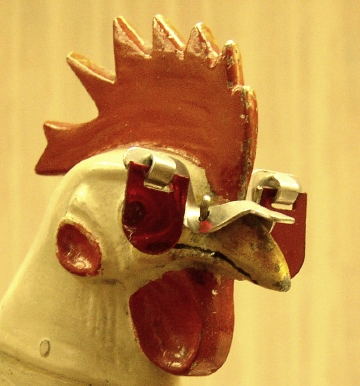Seeing Red in the Hen House

Domesticated hens typically live together in a hen house, centralized so that the farmworkers can collect their eggs without having to travel much. And with any such innovation, there are always downsides. In this case, though, there’s an unexpected one: for some reason, domesticated hens are prone to cannibalism, attacking their housemates by pecking away at an injured bird’s feathers, devouring its flesh, and eventually, killing the attacked bird.
For the farm, a cannibalized bird is a problem, and many methods of limiting this behavior have been explored over the course of decades if not centuries. Decreasing the size of the group of hens is effective but, given other demands of an industrialized farm, counterproductive. Selective breeding of chickens helps but, of course, requires access to chickens that are not as prone to cannibalism as others — which at times is impossible to determine until too late. The most common solution is called beak-trimming (and is exactly what it sounds like), which per one study, can reduce death by cannibalism by nearly two-thirds. But perhaps the most curious solution is the one seen above — red-tinted sunglasses, designed especially for hen house chickens.
And: they worked. Most likely, chickens are opportunistic in their cannibalism — they attack only when they see that another chicken is bleeding, and go after that chicken. By putting red-tinted lenses over the chickens’ eyes, the birds cannot as easily tell the difference between blood and other things in their surroundings, and, in absence of blood, remain docile. The glasses were manufactured and marketed starting in 1939 by the National Band & Tag Company, whose website has many pictures of the glasses (including the one above) and of newspaper clippings advertising the sale thereof. Others manufactured the eyewear as well, and as recently as 1973, farmers used these spectacles as a way of preventing chicken-on-chicken massacres.
But the glasses fell out of favor as being inhumane, even when compared to beak-trimming. In order to hold the glasses in place, a pin was inserted through the chicken’s nostrils. This practice is outlawed in some places (such as the United Kingdom, as of 1982) and is generally frowned upon elsewhere.
Bonus fact: The 1960 movie Alfred Hitchcock movie Psycho is a classic slasher movie, focusing on the murder of a hotel guest while she is taking a shower. The murder scene features the guest’s blood running down the drain, but, as the movie is black and white, we assume the blood is red. It isn’t. Hitchcock used chocolate syrup for the “blood,” believing that its texture and density were superior to prop stage blood, and realizing that the color would not be seen by moviegoers anyway.
From the Archives: Temporary Blindness: The article itself is related, somewhat; the bonus fact puts it over the top.
Related: While chicken sunglasses like the type described above are no longer easily found, you can always settle for these.

Leave a comment